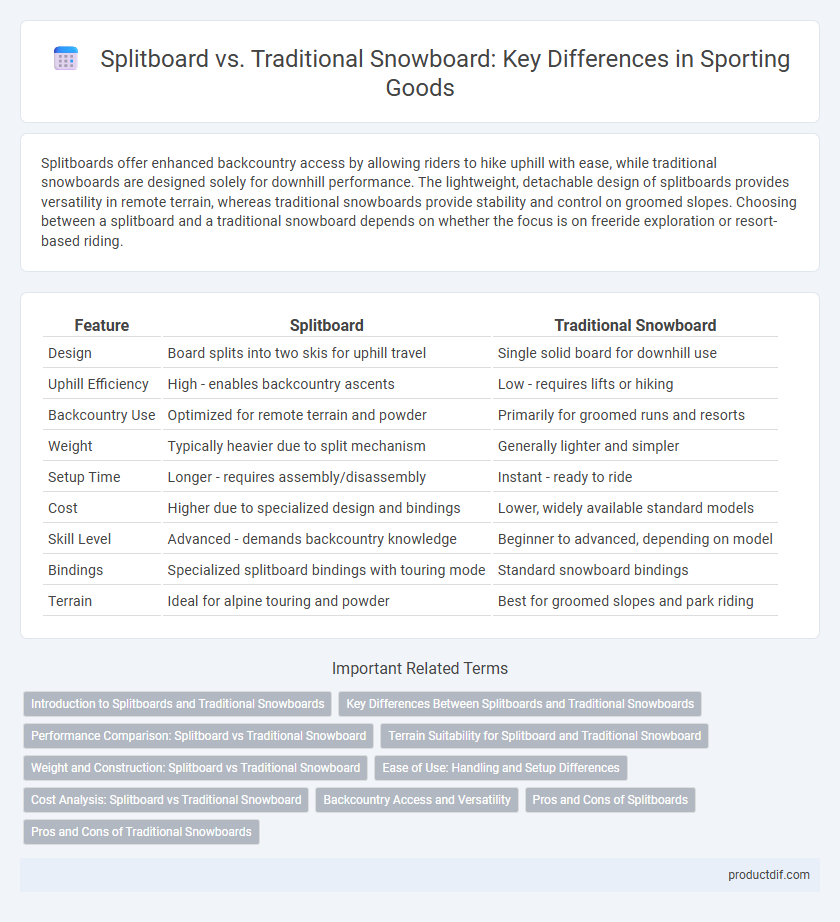Splitboards offer enhanced backcountry access by allowing riders to hike uphill with ease, while traditional snowboards are designed solely for downhill performance. The lightweight, detachable design of splitboards provides versatility in remote terrain, whereas traditional snowboards provide stability and control on groomed slopes. Choosing between a splitboard and a traditional snowboard depends on whether the focus is on freeride exploration or resort-based riding.
Table of Comparison
| Feature | Splitboard | Traditional Snowboard |
|---|---|---|
| Design | Board splits into two skis for uphill travel | Single solid board for downhill use |
| Uphill Efficiency | High - enables backcountry ascents | Low - requires lifts or hiking |
| Backcountry Use | Optimized for remote terrain and powder | Primarily for groomed runs and resorts |
| Weight | Typically heavier due to split mechanism | Generally lighter and simpler |
| Setup Time | Longer - requires assembly/disassembly | Instant - ready to ride |
| Cost | Higher due to specialized design and bindings | Lower, widely available standard models |
| Skill Level | Advanced - demands backcountry knowledge | Beginner to advanced, depending on model |
| Bindings | Specialized splitboard bindings with touring mode | Standard snowboard bindings |
| Terrain | Ideal for alpine touring and powder | Best for groomed slopes and park riding |
Introduction to Splitboards and Traditional Snowboards
Splitboards feature a design that separates into two ski-like sections for uphill climbing, enhancing backcountry accessibility compared to traditional snowboards. Traditional snowboards offer a solid, single-piece structure ideal for downhill performance and park tricks. Both types cater to different snowboarding styles, with splitboards emphasizing versatility in varied terrain and traditional boards focusing on stability and control on established slopes.
Key Differences Between Splitboards and Traditional Snowboards
Splitboards differ from traditional snowboards by offering a two-piece design that separates into skis for uphill travel and reattaches for downhill riding, enabling backcountry access without lifts. Traditional snowboards, single and solid, lack this versatility, requiring carriers or hiking for uphill movement. The hardware components like specific bindings and climbing skins in splitboards optimize traction and transition efficiency, contrasting with fixed bindings on standard snowboards.
Performance Comparison: Splitboard vs Traditional Snowboard
Splitboards offer superior versatility for backcountry riders by allowing efficient uphill travel without the need for separate climbing skins, while traditional snowboards excel in downhill performance with greater stability, edge control, and responsiveness. The splitboard's design sacrifices some stiffness and pop compared to conventional snowboards, resulting in slightly reduced performance on groomed terrain and high-speed carving. Advanced riders seeking a balance between ascent capability and descent quality often choose splitboards, whereas those prioritizing pure downhill performance prefer traditional snowboards.
Terrain Suitability for Splitboard and Traditional Snowboard
Splitboards excel in backcountry and alpine terrain, offering enhanced mobility and access to untouched powder through uphill climbing capabilities. Traditional snowboards perform best on groomed resorts and established trails, providing stability and control for freestyle and downhill riding. Terrain adaptability makes splitboards ideal for remote exploration while traditional snowboards suit varied park and piste environments.
Weight and Construction: Splitboard vs Traditional Snowboard
Splitboards feature a lightweight construction using carbon or fiberglass reinforcements to reduce weight for uphill travel, while traditional snowboards are generally heavier due to solid one-piece builds designed for downhill performance. The splitboard's dual-component design includes metal hinges and hooks that add minimal weight without compromising durability, optimizing backcountry mobility. In contrast, traditional snowboards emphasize rigid, dense core materials like wood or foam composites to enhance stability and pop during descent.
Ease of Use: Handling and Setup Differences
Splitboards offer enhanced ease of use in backcountry terrain by allowing riders to convert their board into two skis for uphill travel, simplifying ascent handling compared to traditional snowboards. The setup process for splitboards involves attaching climbing skins and hardware, which can take extra time but provides greater versatility and control during climbs. Traditional snowboards require no conversion but offer less maneuverability and increased fatigue on uphill routes, making splitboards more efficient for mixed terrain navigation.
Cost Analysis: Splitboard vs Traditional Snowboard
Splitboards typically cost 25-40% more than traditional snowboards due to their specialized design and added hardware like skins and bindings. While initial investment is higher, splitboards offer versatility for backcountry touring, potentially reducing the need for separate hiking gear. Traditional snowboards are generally more affordable and suitable for resort riding but lack the multi-purpose functionality of splitboards, impacting long-term value.
Backcountry Access and Versatility
Splitboards provide superior backcountry access by allowing riders to climb uphill with touring skins, transforming the board into two skis for efficient ascents on varied terrain. Traditional snowboards limit mobility to downhill only, requiring alternative equipment or hiking for backcountry exploration. The versatile design of splitboards expands terrain options and enhances multi-day backcountry trips, making them ideal for exploring remote mountain areas.
Pros and Cons of Splitboards
Splitboards offer backcountry snowboarders the advantage of uphill travel using climbing skins, allowing access to remote powder without relying on ski lifts. They are heavier and less responsive compared to traditional snowboards, which can affect downhill performance and maneuverability. Traditional snowboards excel in stability, edge control, and are more durable for park or resort riding but lack the uphill mobility of splitboards.
Pros and Cons of Traditional Snowboards
Traditional snowboards offer superior stability and control on groomed slopes and in freestyle terrain due to their rigid construction and continuous base. They typically provide better edge hold and carving ability compared to splitboards, making them ideal for park riders and downhill enthusiasts. However, traditional snowboards lack the versatility for backcountry touring, requiring lifts or hiking rather than efficient uphill travel like splitboards.
Splitboard vs Traditional snowboard Infographic

 productdif.com
productdif.com